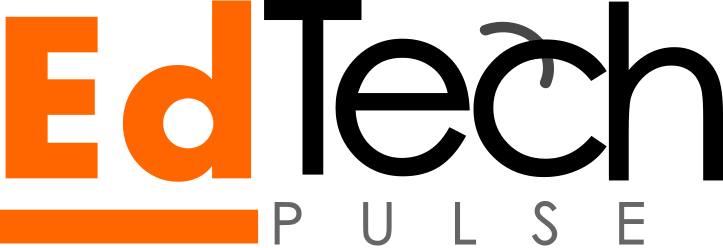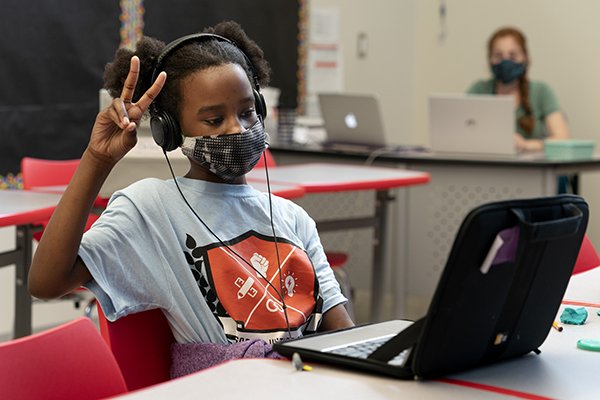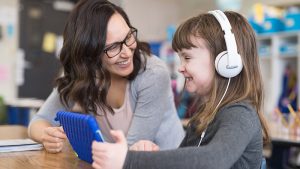A New Era of Learning
The global shift in education brought on by the COVID-19 pandemic forced schools to embrace digital learning almost overnight. What began as an emergency response has now evolved into a lasting transformation — the hybrid classroom. This blend of in-person instruction and digital learning tools is no longer a trend; it’s the future. As the dust settles, educators and institutions are reevaluating their strategies to make learning more flexible, accessible, and effective for all learners.
What is Hybrid or Blended Learning?
Sometimes referred to as “hybrid learning,” blended learning is the combination of traditional teaching environments (in-person classrooms) with digital environments and tools. Blended learning gives students greater flexibility and variety in their education and makes more materials available to students with different learning types.
In this article, we explore the growing momentum behind hybrid learning, examine real-world case studies, highlight the most impactful tools, and offer strategies for empowering educators in this dual-format environment.
Why Hybrid Learning is Here to Stay
Hybrid learning — sometimes called blended learning — combines the best of traditional face-to-face education with the flexibility and scalability of digital tools. Here’s why it’s gaining traction globally:
- Flexibility: Students can learn at their own pace, revisit content, and access materials anytime.
- Resilience: Institutions are better prepared for disruptions, be it pandemics, political instability, or natural disasters.
- Personalization: Digital platforms can tailor learning experiences based on individual student progress and preferences.
- Inclusivity: Students in remote or underserved areas can gain access to quality resources and instructors.
However, reaping these benefits requires thoughtful implementation, solid infrastructure, and continuous support for educators.
Case Studies: Hybrid Learning in Action
1. Lagos, Nigeria – The Bridge International Academies

Bridge has implemented a hybrid model in its network of low-cost schools across Africa. Teachers use handheld devices to access scripted lessons, while students engage with both printed and digital materials. Post-COVID, Bridge integrated more online elements to sustain learning during closures and beyond.
Impact:
- Improved test scores in literacy and numeracy
- Increased attendance and parent engagement
- Scalable model replicated across multiple regions
2. Singapore – Ministry of Education’s Blended Learning Framework

Singapore officially adopted a blended learning framework for secondary schools. Students attend classes 4 days a week and participate in online learning 1 day weekly. This model is supported by the Student Learning Space (SLS), a national digital platform.
Impact:
- Encourages self-directed learning
- Enhances digital literacy and time management
- Strong institutional support for teachers
3. California, USA – Summit Public Schools

Summit uses a personalized learning platform that allows students to set goals, learn at their own pace, and receive real-time feedback from mentors. Face-to-face time is focused on project-based learning and collaboration.
Impact:
- High college acceptance rates
- Strong student-teacher relationships
- Students take ownership of learning
Tools That Power Hybrid Learning
An effective hybrid classroom depends on the right technology. Here are some widely adopted tools supporting this transition:
- Learning Management Systems (LMS): Platforms like Google Classroom, Moodle, and Canvas organize content, assignments, and communication.
- Video Conferencing Tools: Zoom, Microsoft Teams, and Google Meet enable real-time virtual instruction and collaboration.
- Assessment Tools: Kahoot!, Quizizz, and Edpuzzle make formative assessments engaging and digital-friendly.
- Collaboration Platforms: Tools like Padlet, Jamboard, and Miro allow students to work together regardless of location.
- Content Creation: Teachers use tools like Loom, Canva, and Explain Everything to produce engaging instructional content.
- Analytics Dashboards: Tools such as ClassDojo and Edmodo help track student engagement and performance.
The selection of tools should be driven by pedagogy — not the other way around. The goal is to enhance learning, not complicate it.

Training Teachers for the Hybrid Future
A hybrid classroom demands new competencies from teachers. They must be tech-savvy, flexible, and adept at managing both in-person and online learners simultaneously. Yet many educators still lack sufficient training.
Challenges Faced by Teachers:
- Tech Confidence: Many educators are digital immigrants who didn’t grow up with these tools.
- Workload Management: Designing lessons for both digital and physical spaces can double the effort.
- Student Engagement: Keeping remote and in-person students equally engaged is no small feat.
Strategies for Building Teacher Capacity:
1. Pre-service and In-service Training Teacher education programs must integrate digital pedagogy from the start. Professional development must be ongoing, not just a one-off workshop.
2. Peer Learning and Communities of Practice Schools can create teacher-led tech clubs or learning circles where educators share tips, troubleshoot problems, and co-create lesson plans.
3. Microlearning Modules Short, on-demand training videos or tutorials allow teachers to learn specific skills (e.g., setting up an LMS, recording a lesson) as needed.
4. School-based Support Teams Appoint tech-savvy staff or IT coordinators who provide just-in-time support during the school day.
5. Mental Health and Work-Life Balance Training shouldn’t just be technical — emotional support, time management strategies, and workload balancing are crucial to long-term sustainability.
Infrastructure Matters
Hybrid learning cannot succeed without foundational infrastructure:
- Reliable Internet Access: Especially in underserved regions, internet connectivity must be a priority.
- Power Supply: Devices are useless without a stable electricity supply.
- Devices for All: Governments and NGOs must prioritize providing laptops or tablets to students and teachers.
- Technical Support: Schools should have maintenance personnel or hotlines for hardware and software issues.
Policymakers must view EdTech as part of essential educational infrastructure, not a luxury.
Recommendations for Stakeholders
For Schools and Educators: Adopt a pedagogy-first mindset. Technology should support — not lead — teaching goals. Invest in teacher training and seek feedback from students on what tools help them learn best.
For EdTech Companies: Design tools that are user-friendly and context-aware. Prioritize features that support real learning outcomes over flashy interfaces. Offer training and support materials tailored to educators’ needs.
For Government and Policymakers: Develop national or state-wide hybrid learning frameworks. Fund infrastructure upgrades in public schools. Incentivize teacher digital upskilling and support public-private partnerships for sustainable tech implementation.
Conclusion: Embracing the Hybrid Advantage
Hybrid learning is not a stopgap or a post-pandemic fallback. It represents a strategic evolution in how we teach and learn. When implemented thoughtfully, it fosters greater personalization, flexibility, and resilience in education systems.
But this future won’t be built on technology alone. It depends on trained teachers, robust infrastructure, and a shared commitment from all stakeholders to put pedagogy first. The hybrid advantage is real — but only if we work together to unlock its full potential.





